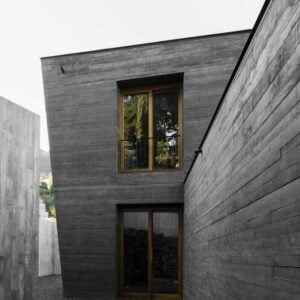In the realm of modern architecture, the fusion of form and function often leads to breathtaking results. One such marvel is the use of concrete in rotated home designs. This blend of robust material with innovative design offers a fresh perspective on contemporary living, where elegance meets practicality.


The Timeless Beauty of Concrete
Concrete, often perceived as cold and industrial, has been reimagined in the world of home design. Its versatility and durability make it a favorite among architects, allowing them to mold it into shapes that defy traditional norms.
In rotated home designs, concrete takes on a new dimension. Its rough texture contrasts beautifully with the sleek lines of the rotation, creating a visual spectacle that is both raw and refined.
The choice of concrete is not just about aesthetics. It offers practical benefits, from insulation to durability, ensuring that the home stands the test of time.
Moreover, the natural grey hue of concrete complements a wide range of palettes, allowing for greater flexibility in interior design.
Lastly, concrete, with its inherent strength, provides the structural integrity required for bold rotations, making the design both safe and stunning.

Rotated Designs and Spatial Dynamics
Rotation in home design is not just a stylistic choice; it’s a strategic one. By rotating sections of the house, architects can optimize natural light, enhance ventilation, and offer panoramic views.
Concrete, with its malleable nature, becomes the perfect medium for these rotations. It can be molded and set in precise angles, ensuring that the rotation is both aesthetically pleasing and structurally sound.
The interplay of light and shadow in these rotated structures creates a dynamic living environment. As the sun moves across the sky, the angles cast ever-changing patterns, making each moment unique.
Furthermore, the rotation allows for innovative interior layouts, with spaces flowing seamlessly into one another, breaking the monotony of traditional designs.
The result is a home that is not just a structure but an experience, where every corner holds a new surprise.

Sustainability and Modern Materials
In today’s world, sustainability is not just a buzzword; it’s a necessity. Concrete, when used responsibly, offers an eco-friendly solution for modern homes.
In rotated designs, the use of concrete is optimized to reduce wastage. The precise angles ensure that there’s minimal excess, making the construction process more efficient.
Furthermore, concrete’s thermal properties make it an excellent insulator, reducing the need for artificial heating and cooling. This not only cuts down on energy consumption but also ensures a comfortable living environment.
The use of sand-blasted pine strip shuttering in the concrete casting process further enhances the sustainability quotient. This technique, which gives the concrete its unique texture, uses natural materials, reducing the environmental impact.
Thus, rotated concrete homes stand as a testament to the fact that elegance and eco-friendliness can go hand in hand.

The Future of Rotated Concrete Homes
As architectural trends evolve, the role of materials like concrete in rotated designs is set to grow. With increasing emphasis on sustainability and innovation, these homes offer a glimpse into the future of urban living.
The flexibility of concrete, combined with its durability, makes it an ideal choice for bold designs that challenge traditional norms.
Moreover, as urban spaces become more constrained, the need for innovative layouts will rise. Rotated designs, with their ability to maximize space and offer unique perspectives, will become increasingly popular.
The tactile nature of concrete, with its rough texture and cool touch, will continue to appeal to those seeking a blend of modernity and nature.
As we look ahead, it’s clear that rotated concrete homes will continue to inspire, setting new benchmarks in architectural excellence.

Conclusion
Concrete elegance in rotated home designs represents the pinnacle of modern architecture. It’s where form meets function, tradition meets innovation, and aesthetics meets sustainability. As we stand at the crossroads of architectural evolution, homes like these serve as beacons, guiding us toward a future that is both beautiful and responsible.












